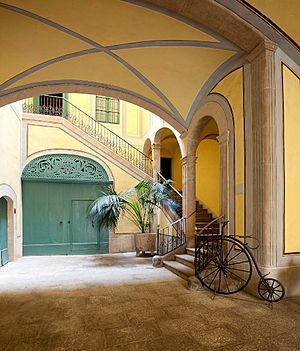Can Papiol Romanticism Museum facts for kids
The Can Papiol Romanticism Museum is a special place in Vilanova i la Geltrú, a town in Catalonia, Spain. It's not just any museum; it's an old, grand house called a manor house. This house was built a long time ago, at the end of the 1700s. Inside, you can see furniture and decorations that show what life was like back then. The museum helps us imagine what it was like to live as a wealthy family in the 1800s. It's also part of a group of museums connected to the Barcelona Provincial Council.
History of the Museum
The story of the Can Papiol Museum began in 1959. A person from the Papiol family, who owned the house, sold it. They sold the house and all its furniture to the Barcelona Provincial Council. The idea was to turn this beautiful old house into a museum for everyone to enjoy.
After some work to fix up the house, the museum opened its doors in 1961. For a while, it was linked with another museum in Sitges. But in 1995, the two museums started to be managed separately.
Exploring the Can Papiol Building
The Can Papiol house is a large and impressive building. It has a ground floor, a first floor, two more floors above, and even an attic. A smart person named Francesc de Papiol built this house between 1790 and 1801. He was a politician and a scholar.
The house is built in a style called Neoclassical. This means it looks like old Greek and Roman buildings. You can see painted decorations on the walls, like stone blocks (ashlars), columns, and triangular shapes (tympanums). Inside, the main room has special paintings called grisailles. These paintings look like sculptures and show scenes from the Bible.
The museum also has a lovely garden. This garden was designed in the Romantic period style. By looking at how a rich family lived every day, the museum helps us understand what society was like in the 1800s.
See also
 In Spanish: Museo Romántico Can Papiol para niños
In Spanish: Museo Romántico Can Papiol para niños
- Biblioteca Museu Víctor Balaguer
- Can Llopis Romanticism Museum


